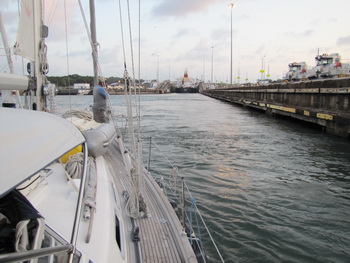
Transiting the
Panama Canal
March 2010
Part Five
| |
| HOME |
| About Tenaya |
| About Us |
| Latest Update |
| Logs from Current Year |
| Logs from Previous Years |
| Katie's View |
| Route Map |
| Links |
| Contact Us |
![]()
March 31, 2010
Transiting the Panama Canal in a small sailboat is exciting and a bit daunting. We'd read in guidebooks and on blogs that it is a good idea to go through first as a linehandler on another yacht to gain experience. That seemed like a really good idea so on Thursday, March 25 Jim and I joined the crew of Artemo, a Canadian flagged ketch and Mike hopped aboard Legend II, our kiwi friends.
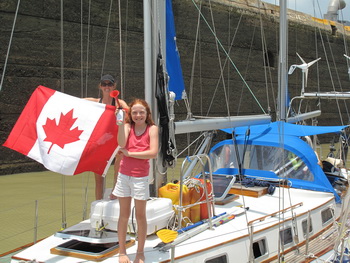
Julie and Amelia of Artemo wave a flag in the Miraflores Locks
Earlier that morning as I climbed onto Tenaya I saw something floating in the water. Thinking it was some sort of cover that had blown off of a boat in the marina, I looked over the stern. There were two gray blobs floating at the surface with fish swimming about them. They were live creatures ... they were manatees! Occasionally moving their heads to break the surface, they floated nearly motionless. I called to Jim to come see and then to the man on the boat across from us. Then I just hollered "manatees, manatees" and pointed for everyone to see.
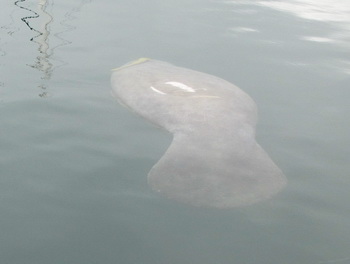
Manatee in Shelter Bay Marina
A canal across the Isthmus of Panama had been imagined as early as 1534 when a catholic priest suggested that the king of Spain could have people dig through the mountains and connect the two oceans. Nothing came of that suggestion but the Spanish did pave extensive cobblestone mule trails to bring the Peruvian gold from the Pacific across the mountains and jungle to the Atlantic.
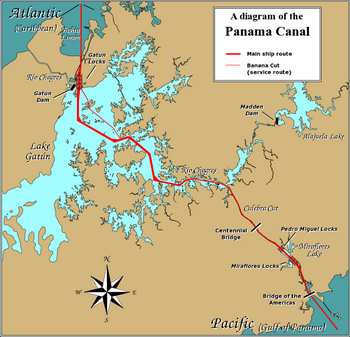
The Panama Canal runs roughly north to south
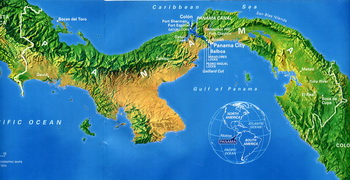
The country of Panama runs east to west and is shaped like an S
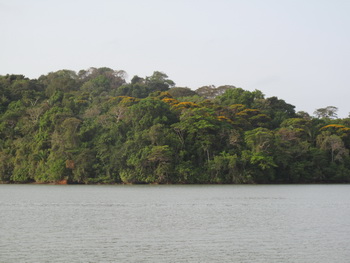
The canal is cut through jungles and mountains
In 1850 construction began on the Panama Railway which opened in 1855 after 5 years of struggle, the loss of 10,000 lives and at a cost of $8 million. It became an instant success and in the following decade 400,000 people crossed the Isthmus on it.
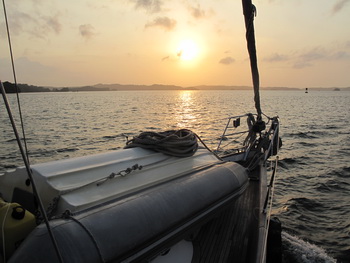
Tenaya heads across Gatun Lake early the second morning
Three centuries after the priest's suggestion Count Ferdinand de Lessups created the Compagnie Universelle du Canal Interoceanique de Panama in 1879. He had been responsible for the successful sea-level Suez Canal. Colombia granted them the exclusive privilege, valid for 99 years, to construct a waterway across the country. In return, the company was obligated to deposit 750,000 francs in a London bank no later than 1882. Colombia was also to receive 5% of the gross revenues in the first 25 years of operation, 6% for the next 25 years, 7% for the next 25 years and 8% in the final 25 years. Another clause in the contract was that the minimum payment was never to be less than $250k which was what Colombia was earning with the Panama Railroad. Colombia conceded 500,000 hectares of land for the canal as well as a 200 meter strip of land on each side. At the end of the 99 years the canal and all the equipment would revert to Colombia.
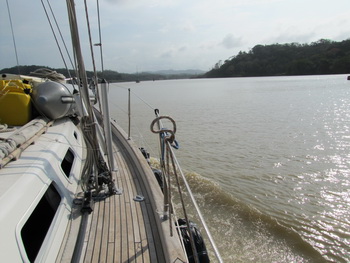
motoring across Gatun Lake
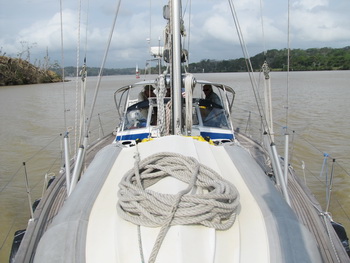
Work officially began in 1880 to create a sea-level canal. Disease, the harsh geographic and climactic conditions, underfunding and mismanagement caused the company to fold in 1889 after costing $285 million and killing 20,000 people, more than any other project ever except war.
In 1894 a second French company emerged to resume work on the canal. They recommended construction of a lock-type canal because of heavy flooding of the Chagres River. This company also failed and bankruptcy forced them to sell the canal equipment as well as all the rights and ownership. The United States government snapped them up. Meanwhile the Colombians were happy with the revenue they received from the railway and thought the expense of building the canal was too great. The Colombian state of Panama endorsed the canal and was prepared to secede if the Colombian congress did not proceed with construction. They proposed that after secession they would enter into a treaty with the United States giving that government the equivalent of absolute sovereignty over the Canal Zone. In return the president of the U. S. would promptly recognize the new government and would appoint a minister to negotiate and sign a canal treaty.
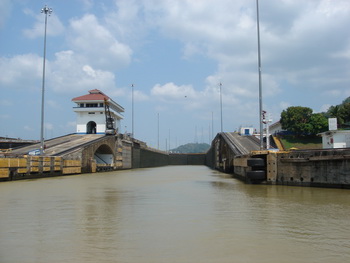
Entering the first of the Gatun Locks
Following Panama's declaration of independence from Columbia, Panama and the United States signed the treaty allowing the U. S. to construct the canal across the Isthmus. After ten years, almost $400 million and the labor of 57,000 men and women, the canal was complete.
Unprecedented problems such as the Isthmus' unique geology and constant threat of landslides, the enormity of the locks and sheer volume of excavation required, establishment of entirely new communities and importation of every last nail faced the canal builders, not to mention disease.
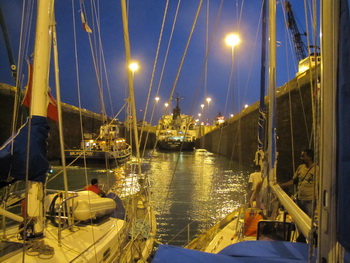
In the last of the Gatun Locks after sunset
Amazing feats by many people contributed to the success of the project. Col. Williams Crawford Gorgas and his medical team are credited with eradicating yellow fever and bringing malaria under control in the area, Chief Engineer John Stevens set up the towns, supply system and train system to haul excavated material out of the Gaillard Cut, Col. George Washington Goethals and his staff drew the final engineering designs and pushed through the excavation of the Cut as well as the locks and Gatun Dam construction, and thousands of others helped.
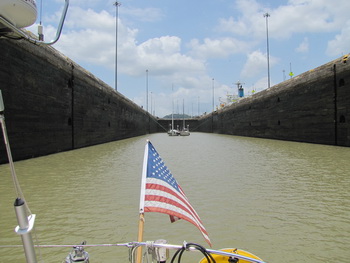
Miraflores Lock seems enormous with no large ship inside
The Panama Canal opened to traffic on August 15, 1914. Completed below budget, ahead of schedule and without a hint of corruption, it has seen more than 850,000 transits. An aggressive maintenance program keeps the canal in top operating condition. Over the years the channel has been straightened, widened and deepened. Construction has begun to add another set of locks parallel to the Gatun Locks on the Atlantic side. These locks will recycle the majority of the water used to raise and lower the locks rather than waste it.
The opening of the canal was the end of the great age of sailing. The canal allowed steamships and motor driven ships to shave weeks, even months, off the time it took to deliver goods between the Atlantic and Pacific. Sailing ships could not transit the canal from the Pacific side as it lies in the doldrums with little wind for propulsions.
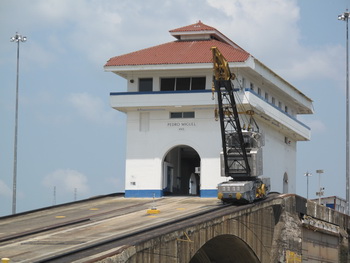
Trains help large ships move through the locks, this one is at Pedro Miguel Lock
In 1977 the Trios treaty was signed between the Republic of Panama and the United States. Under the treaty the canal was run as a U. S. Governmental agency by the Panama Canal Commission, now defunct. The Commission was supervised by a bi national board of directors composed of five U. S. citizens and four Panamanians. It stipulated the elimination of the canal administration and ultimately the transfer of the Panama Canal to the Republic of Panama at noon on December 31, 1999.
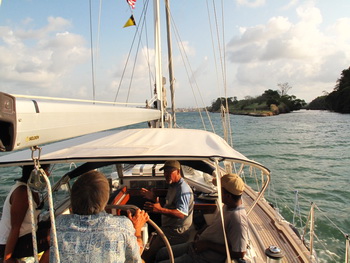
Islands dot Gatun Lake
The Panama Canal is 50 miles long from deep water in the Atlantic to deep water in the Pacific. It was cut through one of the narrowest places and at one of the lowest saddles of the long Isthmus of Panama which joins the North and South American continents. The original elevation was 312 feet above sea level where it crosses the Continental Divide in the Rouge mountain range.
Four foot diameter wells in the floors of the locks admit water from conduits into the chambers during up lockage's. Water boils furiously from the pressure and fills the huge lock in less than 15 minutes. This can cause the rafted yachts to really dance around.
The following is our experience transiting the Panama Canal on March 27-28, 2010:
We were told to secure four linehandlers which could be crew, other yachties, professionals, or a combination. We had two crew and asked our friend, Craig, to help. Rudy, a longtime professional, was hired. What a competent, interesting and nice person he is!
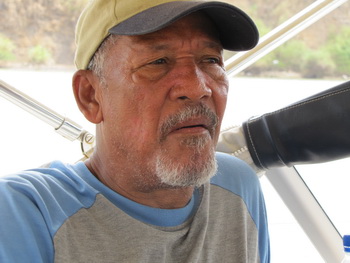
Rudy has been through the canal over 1000 times!
Four 125 foot lines at least 7/8" in diameter and plenty of fenders are necessary. Tires are recommended. Our helpful agent, Tina McBride, arranged for these along with everything else to ensure a timely, stress-free transit. She also suggested we use Rudy. We highly recommend her.
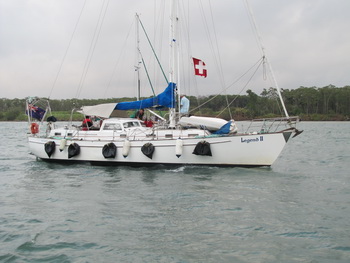
Legend with tires and fenders
We were told to be at the Flats Anchorage by 3:00 pm on the assigned day to receive our transit advisor. We were thrilled to see it was Ricky as we'd had so much fun with him on Artemo. Advisors do this as a second job to gain experience and become pilots on larger ships. Ricky's main job is as a hydrographer in the canal.
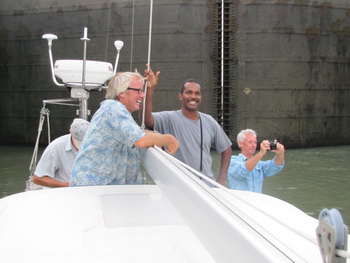
Ricky knows his stuff and is loads of fun
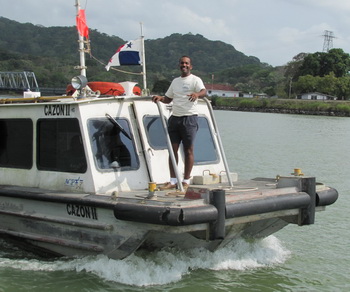
Ricky says hello while working his "real" job
.
At 4:15 pm all the yachts motored over to the first Gatun Lock and stopped to raft up before entering. The boat with the most horsepower, usually the largest, is in the center position. The other boat rafted to its port side and then we tied to its starboard side.
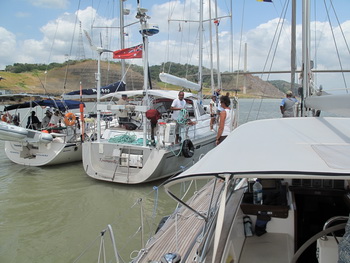
Tenaya approaches the center boat to raft up
The boats motored together into the lock with the center boat driving and the side boats providing additional steerage.
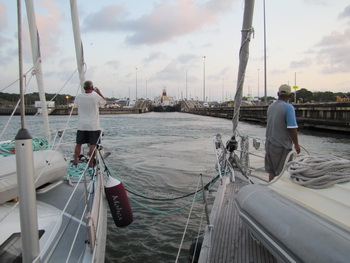
The rafted boats enter the lock
Two workers on each side of the canal tossed monkey fists carrying light lines to each of the outer boats, one to the bow, one to the stern. These are tied to our heavy lines to be hauled up and secured to bollards while the boats are raised or lowered in the locks.
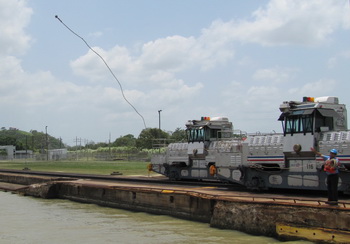
A worker tosses a monkey fist to our bow and another tosses one to our stern. Heads up ... these things can do some damage!
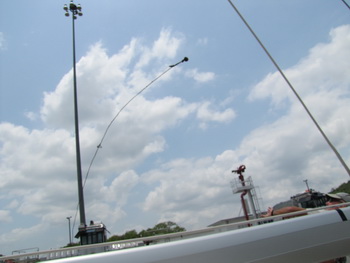
The boats stayed rafted together as they passed through each of the three Gatun Locks. Once they had been raised and the gates opened, workers on each side of the lock released the large lines which were hauled back on board. The workers pulled the yachts through to the next lock by the lighter lines. Once in position the heavy lines were hauled back up to the side of the lock and dropped around a bollard.
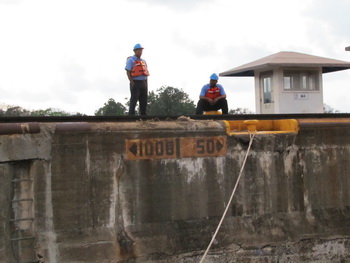
The heavy bow and stern lines are attached to bollards in the locks
Boats are lifted up in the Gatun Locks to reach the elevation of Gatun Lake and then lowered in the Pedro Miguel and Miraflores Locks to reach sea-level at the Pacific.
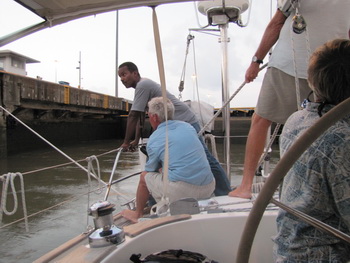
Craig adjusts the heavy stern line from the side of the lock
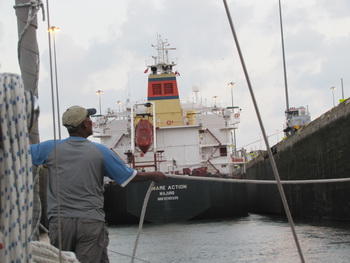
Rudy controls the bow line as we rise in one of the Gatun Locks
There can be a great deal of turbulence in the canal as water rushes in or out. The lines are eased or tightened accordingly. The outer boats are directed by the advisor of the center boat to power forward, reverse or remain in neutral to keep the raft centered.
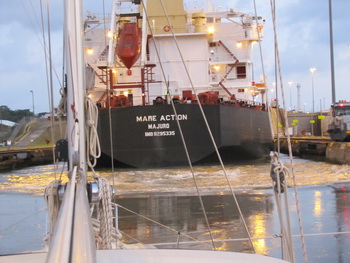
Turbulence comes from the big ship's prop wash as well as the changing levels of water in the locks
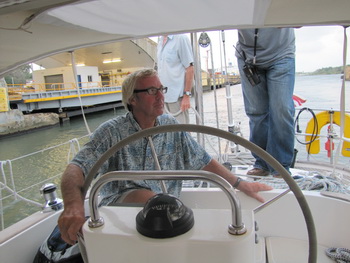
Jim watches for instruction from the center boat's advisor who runs the show
When rising from the Atlantic to Gatun Lake small boats enter behind the large ship with whom they share the lock. When lowering to the Pacific they enter in front of them. Fortunately we went though the second day with only small yachts. The locks seemed enormous with only five sailing yachts in them!
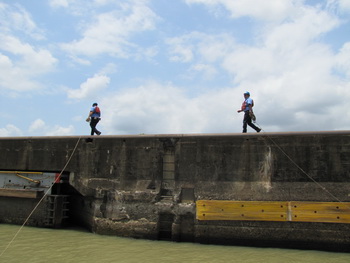
Two workers on each side of the lock walk the rafted boats to the next lock
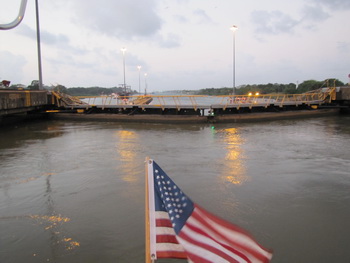
Looking back towards the Atlantic once we were raised in the lock
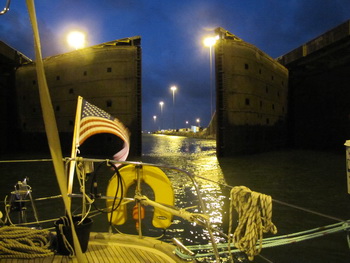
Giant gates close once we are in the lock
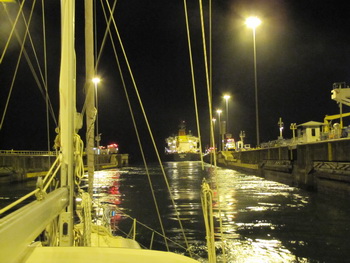
Exiting the last of the Gatun Locks, we entered Gatun Lake about 8:00 pm
We spent the night tied to one of two large buoys in Gatun Lake. These are designed for two yachts to tie on either side and for other yachts to raft up to them.
After eating burritos for dinner in the last lock, Ricky was taken away by boat soon after we tied to the buoy. All others must remain on board. Rudy chose to sleep in the cockpit until it started raining and Craig slept in the sea berth in the main saloon.
At 6:00 the following morning George, that days advisor, was dropped off by boat. The lines were cast off immediately and the yachts began the 23.5 mile trip across Gatun Lake to the Gaillard Cut.
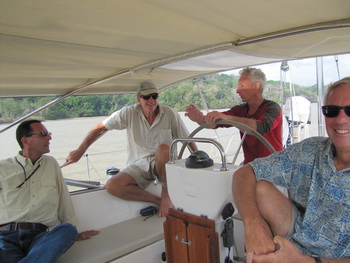
George, our advisor for the second day with Craig, Mike and Jim
Coffee, tea, fresh pineapple and banana bread was served for breakfast. I was prepared to make french toast if anyone wanted more substantial fare but none did.
Yachts must maintain a speed over 6 knots to make it to the first lock, Pedro Miguel, in time. Jim and Mike took turns steering through the channel during the 4 hour trip across Gatun Lake.
Many islands dot the lake and the channel is bordered by dense jungle. It was more beautiful than we'd imagined. Large ships pass in both directions as we motor steadily ahead. In the narrow Gaillard Cut we met a Panamax ship, the largest allowed. They are 965 feet long, 106 feet wide and can carry 4500 containers.
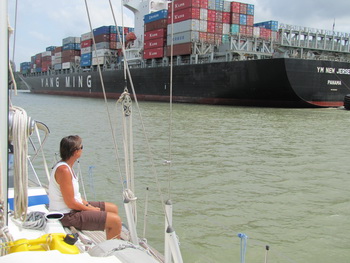
Katie watches as a Panamax ship passes
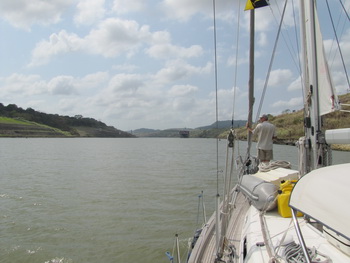
Motoring through the Gaillard Cut
Once through the Gaillard Cut the boats rafted up again to pass through the Pedro Miguel Lock and the two Miraflores Locks. There are cameras at the visitors center at the Miraflores Locks so we hung a large American flag from our port side and Mike and I waved from the bow. We heard from family and friends that we appeared on the camera briefly as we entered the lock but motored out of sight. The camera was aimed at the two boats behind us. Our friend, Jen, saved a shot of us passing by. We are in the first group of boats on the left of the picture and Tenaya is the furthest away. You'll need a magnifying glass to see Mike and Katie on the bow!
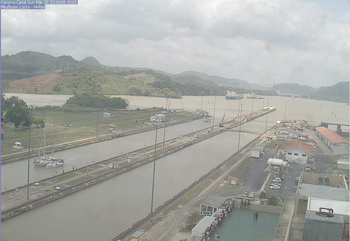
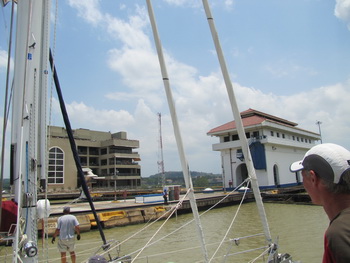
Looking at the visitor's center at Miraflores Locks
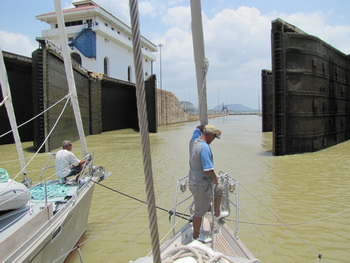
Exiting the Miraflores Locks
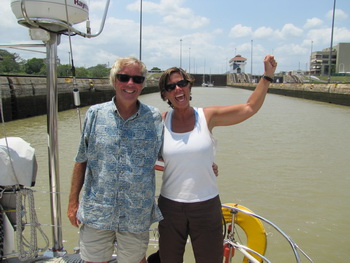
Leaving the last of the locks
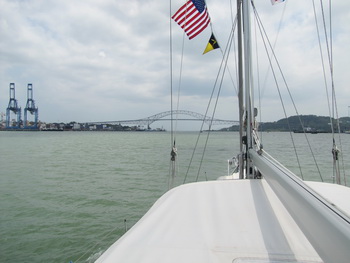
Once under the Bridge of the Americas we were truly in the Pacific
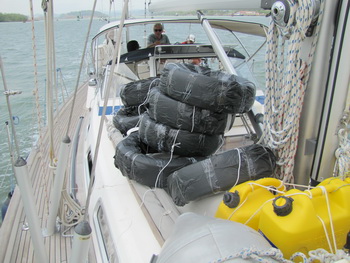
A boat picked up George under the Bridge of the Americas. We untied the 14 tires while Rudy coiled the long lines. Jim steered us to The Balboa Yacht Club just on the other side of the bridge where we docked briefly and dropped off Rudy and the equipment. Tina had arranged for a mooring ball so we tied up and settled in, happy to have fast wifi and showers.
We've been shopping for a few boat supplies and additional lightweight shirts. Yesterday we took a taxi to Los Rios Regional Metropolitan Health Center for yellow fever shots. There have been 9 cases in Panama and French Polynesia is requiring visitors to be immunized if arriving from countries with outbreaks. Funny because the incubation period is 14 days so by the time a yachtie reaches the Marquesas he will either be safe or dead. The Galapagos requires it as well if arriving from an affected country within 14 days, but we've seen nothing of this on blogs or websites. Needing this shot here is new as Panama had eradicated the disease.
We plan to leave Friday to sail, or most likely motor, across the ITCZ (Inter-Tropical Convergence Zone) to the Galapagos Islands 950 miles to the southwest. We will update the tenayatravels page on Facebook along the way. Adios for now!
Go to April 2010 Part One - Panama to Galapagos
.